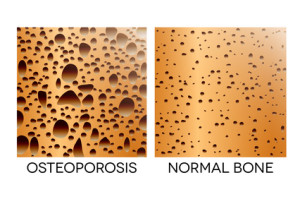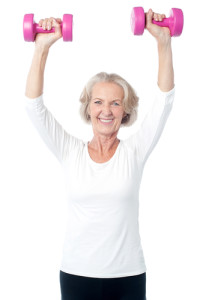What is osteoporosis?
Osteoporosis is a disease that is categorized by the decrease in bone mineral density (BMD)1. It also compromises the architectural strength of bone tissue and will increase the likelihood of fracture3.

The World Health Organization defines osteoporosis as bone density that is 2.5 standard deviations or more below the normal and healthy bone level of an adult.
A common occurrence
In the United States, it is estimated that 13%-18% of the population have osteoporosis³. Women specifically after menopause are particularly subject to the debilitating issues relating to osteoporosis than men.
It is suspected that inactivity, decreased calcium intake, and an increase of re-absorption of bone cells contributes to bone loss.
Osteopenia vs Osteoporosis
Osteopenia refers to bone mineral density (BMD) that is lower than normal peak BMD but not low enough to be classified as osteoporosis.
Bone mineral density is a measurement of the level of minerals (i.e. calcium, magnesium and phosphorus) in the bones, which indicates how dense and strong they are.
If a person’s BMD is low compared to normal peak BMD, then that person has osteopenia.
Having osteopenia means there is a greater risk when time passes and BMD decreases you may develop osteoporosis.
Osteopenia is diagnosed with a bone mineral density (BMD) test, usually done to see if a person has osteoporosis.
The most accurate test of BMD is dual-energy X-ray absorptiometry (DEXA).
DEXA is a form of X-ray that can detect as little as 2% of bone loss per year. A standard X-ray is not useful in diagnosing Osteopenia because it is not sensitive enough to detect small amounts of bone loss or minor changes in bone density.
Aging is associated with decline in total muscular strength and lean body
 Even for an older athlete that is still active, muscular strength declines approximately 15-20% after each year.
Even for an older athlete that is still active, muscular strength declines approximately 15-20% after each year.
However, according to studies, a fitness regime of progressive resistance training program of weight bearing joints will sustain bone density to help prevent the onset of low bone density; potentially leading to osteoporosis. Weight bearing joints in the human body are commonly known as the hip, knee, ankle, and spine.
For an active physically fit senior, an intense progressive resistance program of an intensity of 70% of 1-rm is suggested.
To improve bone mineral density it is necessary to load the bone beyond normal conditions². The resistance training program for the fit senior athlete must be progressive and continuous (or supplemented with desired activities).
In the elder athlete; Osteopenia is a more common issue than osteoporosis because the patient is already active in sports/recreation/activities.
Reprinted with permission from Keith Chittenden, WatchFit.com
References:
1. Petranick, Kimberly and Berg, Kris; The effects of Weight Training on Bone Density of Premenopausal, Postmenopausal, and Elderly Women: A Review, The Journal of Strength and Conditioning Research, 1997, 11(3), 200-208
2. Nguyen, VuH MeD, Loethen Joanne, Lafontaine Tom; Resistance Training and Dietary Supplementation for Persons with Reduced Bone Mineral Density, Strength and Conditioning Journal, Vol. 30, number 5, October 2008
3. Mansfield M. Elaine; Designing Exercise Programs to Lower Fracture Risk in Mature Women Strength & Conditioning Journal, Vol. 28, Number 1, February 2006, pages 24-29
Keith Chittenden is a Certified Strength & Conditioning Specialist with Distinction and a Tactical Strength and Conditioning Facilitator with Distinction from the NSCA; a Golf Fitness Specialist, Corrective Exercise Specialist, and a NASM Master Trainer. He is also a published author and an active contributor to the NSCA’s publications including the TSAC Report and the Personal Trainer Quarterly. Formerly competed as a bodybuilder and strength athlete; He has a devotion and passion in Athletic Conditioning for triathlon, marathon, track, and field sports athletes. At present; he trains clients & athletes privately

